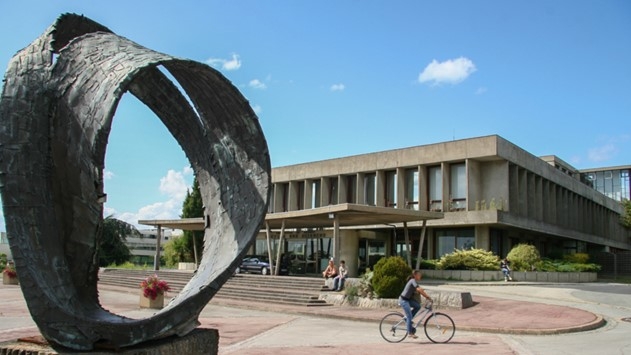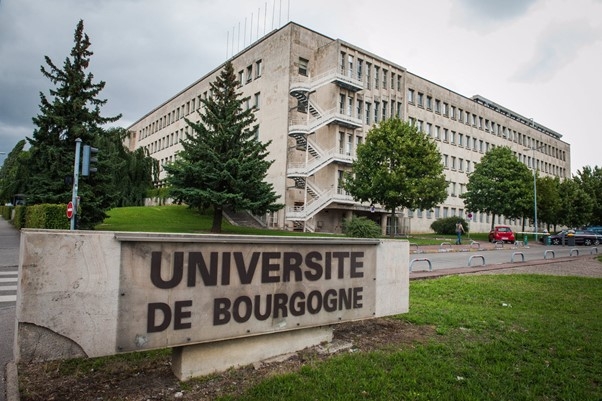Beneficiaries

Université de Rennes 1
Université de Rennes 1 (UR1) is internationally acknowledged as one of the top scientific universities in France. Research at UR1 is organized along four major domains, corresponding to four graduate schools: Mathematics & ICT, Life Sciences, Materials Science, and Humanities & Social Sciences. UR1 includes 29,000 students, 3,700 staff members, 22 joint research units associated with national research centers (e.g. Inria, INSERM, CNRS, INRA) and awards over 250 PhD degrees every year.
Inside UR1, Géosciences Rennes is a Joint research unit supported by the French National Research Centre for Scientific Research (CNRS) and UR1 (60 full-time researchers). Géosciences Rennes is internationally renowned in several domains through field experimental and numerical modelling approaches. It hosts ~10 foreign researchers/year, and publish ~ 160 papers/year. It received top marks during the 2016 evaluation, and several national and international awards.

Université Bourgogne FrancheComté
Université Bourgogne Franche Comté (UBFC) is a community of universities and higher education institutions (COMUE) that has been established by national decree on April 1st 2015. It federates six higher education and research institutions operating in the Bourgogne Franche-Comté region and is in charge of defining a common strategy for research and training. UBFC gathers around 8740 personals among which 2066 assistant professors/professors and 264 permanent researchers, and welcomes around 56000 students every year.
The Université de Bourgogne (“UB”) will be responsible for hosting and training the ESR. UB is a founding member of UBFC and is a multidisciplinary university, offering its 29 390 students 29 departments with 2119 professors and researchers employed, covering the spectrum of Environmental Sciences, Sciences & Technology, Health & Care, Social sciences & Humanities, Political Sciences and Management. UB is hosting 6 doctoral schools with 140 doctoral courses activated this year. The Biogéosciences laboratory is a research unit linked to UB. UB will be involved in the action as a third party with a legal link to the beneficiary, it will be responsible through the Biogéosciences laboratory for hosting and training the ESR(s) that will be recruited by UBFC.

Université de Genève
Université de Genève (UNIGE) is ranked among the best three generalist French-speaking universities and among the 100 best universities worldwide. It is Switzerland’s second largest university with 17’000 students and about 4’000 researchers (including 520 professors) in 9 different faculties (Science; Medicine; Humanities; Law; Theology; Psychology and Educational Sciences; Economics/Management; Social Sciences; Translation/Interpretation). SEES, the section of Earth and Environmental Science participating in this project, is a premier swiss center for the Geosciences, with strong links with leading research institutions across Europe and partnerships with industrial, governmental and non-governmental bodies. Research at SEES covers the broad range of the Earth Sciences and Environment with an interdisciplinary approach to three priority directions in line with sustainable development goals: 1) global changes, 2) natural resources and geoenergies, and 3) natural and anthropogenic risks.
SEES core competences in fundamental earth sciences are in the fields of sedimentary geology, magmatic and volcanic geology, and geochemistry. SEES works with 55 academics, including 20 professors, and further 35 post-docs and 95 PhD students, raising an average of 10M€ of external funding every year. SEES benefits of a wide set of state-of-the-art equipment operated by technical staff, and flagship facilities for dating and tracing geological processes. The Earth Surface Dynamics group (ESD) of Sebastien Castelltort is internationally reputed for its expertise in source-to-sink analyses of sedimentary systems. The ESD has pioneered research on the interactions between solid and fluid earth processes through some of the first recognitions and quantifications of the links between surface processes and magmatism. Several projects funded by the Swiss National Science Foundation and Energy companies (TOTAL, EQUINOR) center on ancient S2S systems in the Pyrenees, the Mediterranean and Gulf of Mexico, with emphasis on sedimentary proxies of paleoclimates and extreme events.

University of Bern
With 17,880 students and 2,880 PhD students, the University of Bern (UBERN) is the third largest university in Switzerland and was ranked 105 in the 2018 Times World University Rankings. UBERN hosts several internationally recognized research centres, such as the Oeschger Centre for Climate Change Research, the Center of Space and Habitability and the Einstein Center, where members of our institute are actively involved in the framework of collaborative projects including Prof. Schlunegger. The Institute of Geological Sciences, which will be the host department for one ESR, has links with leading research institutions across Europe and partnerships with industrial, governmental and non-governmental institutions. The Institute is composed of 7 research groups, which cover the fields of isotope geology, petrology, mineralogy, tectonics, waterrock interaction, sedimentology and paleoclimate. It hosts more than 40 PhD students, with a large international cohort.
The sedimentology group of Fritz Schlunegger is internationally reputed for its expertise in stratigraphy, sourceto-sink analyses of sedimentary systems, and geomorphology. Several projects funded by the Swiss National Science Foundation have a strong focus on the Alps and the Andes, with emphasis on the routing of sediment from source to deposition. Prof. Schlunegger is member of the presiding board of the Swiss National Science Foundation.

Imperial College London
Imperial College London is Britain’s leading institution for STEM subjects (science, technology, engineering and medicine) and is one of the most prestigious universities in the UK. In 2018-19 it is ranked one of the top 10 institutions globally in the QS world university rankings. The university has more than 17000 students from more than 135 countries, split across faculties in engineering, natural sciences and medicine. The Department of Earth Science and Engineering (ESE), the lead department for this ETN proposal, has 50 academic staff, 80 post-doctoral researchers, 135 PhD students and ca. 400 undergraduate and master’s students. ESE is routinely rated as the top geology department in the UK with an annual research grant income of ca. €14 million.
Research at ESE is divided into three main sections (i) Earth and planets; (ii) computational geoscience and engineering (iii) petroleum geoscience and engineering. The research particularly focuses on how Earth systems work and how natural resources and energy can be sustainably extracted and provided, using a combination of pure and applied research. The Department is aided by strong collaborative ties at Imperial College with the Energy Futures Lab, the Sustainable Gas Institute and the Grantham Institute for Climate Change and the Environment. A key strength of the department’s research is its inter-disciplinary nature; it is one of the only departments in the world that combines Earth science and engineering. The Department of Earth Science and Engineering has a world-leading reputation in the field of earth and planetary surface processes and source to sink sediment dynamics.

University of Bergen
The University of Bergen (UiB) is a young and modern university. The UiB has high level of research and education in all of its seven faculties, Natural Sciences and Mathematics; Medicine and Dentistry; Social Sciences; Humanities; Psychology; Fine Art, Music and Design; and Law. In total, the UiB has 14,450 students and 3,460 faculty and staff. Yearly around 250 candidates are awarded with a PhD degree. UiB holds a significant research profile in marine and climate sciences. The Department of Earth Science (UiB-GEO) embodies research and research-based education within central geological and geophysical disciplines, including marine geoscience, petroleum, Quaternary geology, climate and earthquake-seismology.
The research is conducted on land and sea all over the globe, including extensive activity in the Arctic. UiB-GEO host national and international research infrastructure and runs a number of different research laboratories housing a wide spectrum of modern equipment for analysis and lab experiments. The department has an international profile with more than 110 research positions and 42 technical/ administrative staff members from more than 30 different countries. UiB-GEO is a partner in Centre of Excellence SapienCE, in the K.G. Jebsen Centre for Deep Sea Research and the Bjerknes Centre for Climate Research.

University of Oslo
University of Oslo is one of the World's Top 100 universities, according to the Shanghai World Ranking (no. 62 in 2018). UiO offers world-class research and excellent research-based education, and attracts highly qualified students and researchers from all over the world. UiO is Norway’s oldest and highest ranked public institution of research and higher education with approximately 28 000students, 7 000 employees and 2 700 PhD candidates.
The Department of Geosciences is the broadest geoscientific research environment in Norway, from deep processes in the mantle, to surface processes and atmospheric processes – including their interactions. The Department is considered a world-leading institution as regard insights into the development of the Atlantic Margin. The Tectonnostratigraphic Research Group (TecStrat) at UiO is currently composed of ~15 ESR personnel that complete a multi-disciplinary approach to sedimentary basin development, infill, and their source-to-sink dynamic balancing.

GFZ – Helmholtz Centre Potsdam
The GFZ– Helmholtz Centre Potsdam is Germany’s national research centre for the solid Earth Sciences. Its mission is to deepen the knowledge of the dynamics of the solid Earth, and to develop solutions for grand challenges facing society. In pursuit of its mission, the GFZ has developed a comprehensive spectrum of expertise in geodesy, geophysics, geology, mineralogy, geochemistry, physics, geomorphology, geo-biosciences, mathematics, and engineering. The GFZ currently employs 841 scientific, technical and administrative staff as well as 147 student assistants and apprentices and a further 273 guests (primarily scientists).
The Earth Surface Modelling Section (ESMS) was created in 2016 to strengthen the development of a new initiative to develop expertise in Earth’s surface dynamics and its interactions with climate. Researchers in ESMS develop computer models to simulate the processes responsible for the evolution of the Earth´s surface. In doing so, it provides a framework to integrate field observations and laboratory measurements, and make predictions about places where no data exists or concerning the future evolution of Earth’s surface.

Universitat de Barcelona
Founded in 1450, the University of Barcelona (UB) attracts today over 60,000 students a year, >11000 of which international students from countries worldwide. The UB training offer encompasses all of the major branches of knowledge: the humanities, health sciences, social sciences, experimental sciences and engineering. The 2018 edition of the Europe Teaching Rankings, published by Times Higher Education, placed the University of Barcelona 19th, making it the highest-ranked public university in Spain.
The UB remains the only Spanish member of the League of European Research Universities (LERU) and has bolstered its status as a research-intensive university, ranking 69th in the world in the Reuters Top 100: The World’s Most Innovative Universities. The UB is ranked number 1 in Geosciences among the Spanish universities (I-UGR and BGUR rankings) and among the best 100 of the URAP. The Faculty of Earth Sciences at the UB, with 106 researchers and teaching staff, offers bachelor’s degrees in Geology, Geological and Environmental Engineering, and Marine Sciences, and master’s degrees in Reservoir Geology and Geophysics, Mineral Resources and Geological Hazards, Water Science and Management, and Paleobiology and Fossil Record. Doctoral Programmes include Earth Sciences and Marine Sciences.

Vrije Universiteit Amsterdam
Vrije Universiteit Amsterdam (VuA), founded in 1880, is a leading, innovative and growing university that is at the heart of society and actively contributes to new developments in teaching and research. Our university has ten faculties which span a wide range of disciplines, as well as several institutes, foundations, research centres, and support services. Its campus is located in the fastest-growing economic region in the Netherlands (the Zuidas district of Amsterdam), and provides work for over 4,500 staff and scientific education for more than 23,000 students. Research at the Faculty of Science focuses on the areas of Life & Health, Networked World, Fundamentals of Science, and Energy & Sustainability. The faculty’s teaching activities are directly linked to this excellent research. Cooperation with other faculties on the Vrije Universiteit Amsterdam campus generates attractive, high-quality bachelor and master programs. At international level, the faculty cooperates closely with leading scientific institutes and other partners.
The Department of Earth Sciences strives after excellence in research. Research at the Department of Earth Sciences ranges from Planetary Sciences, Geology, Physical Geography to Hydrology. The department consists of two research clusters: “Earth and Climate” and “Geology and Geochemistry”. The Department can thus study all aspects of System Earth with an integrated dynamical approach. Within the cluster “Earth and Climate”, one of the main research themes is focused on the evolution and variability of the Earth’s Climate in terms of forcings, processes, controlling factors and feedbacks in oceanic, terrestrial and atmospheric transport of heat, water, gasses, and sediments. The department has strong links with industry (e.g. geothermal energy, hydrocarbons, groundwater). In addition, the department’s research addresses societal issues, like climate change and hazards.



